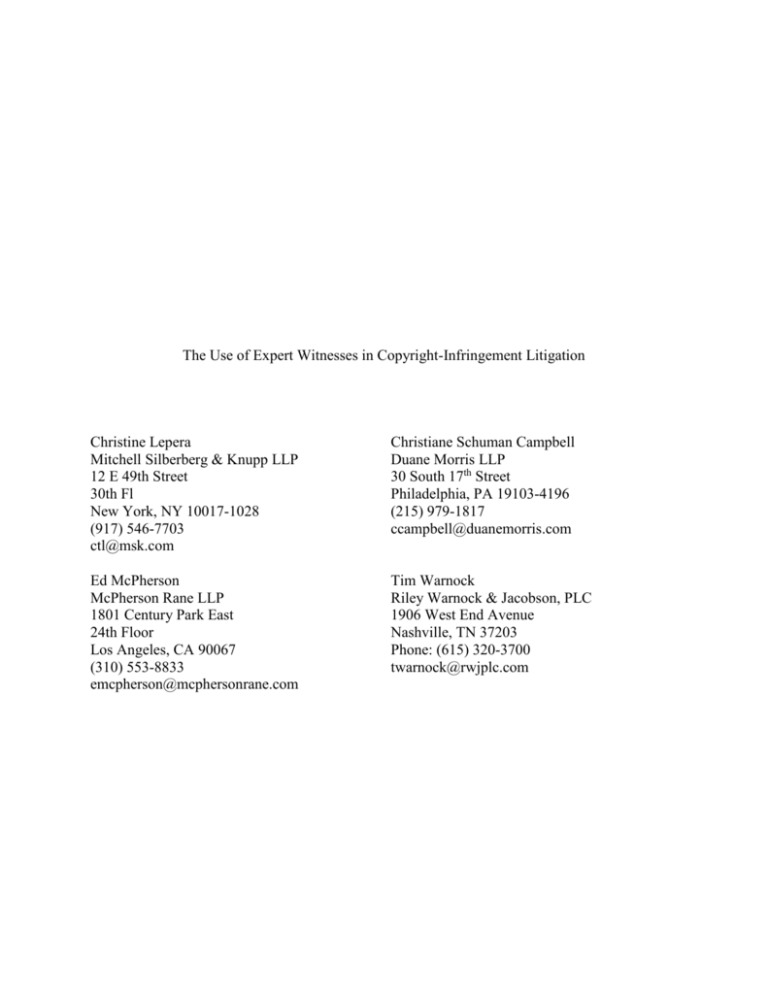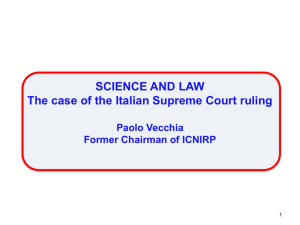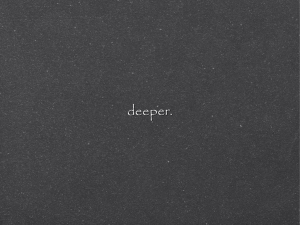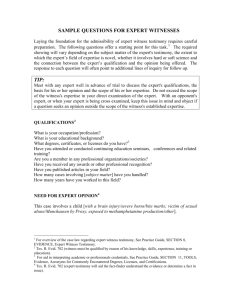The Use of Expert Witnesses in Copyright
advertisement

The Use of Expert Witnesses in Copyright-Infringement Litigation Christine Lepera Mitchell Silberberg & Knupp LLP 12 E 49th Street 30th Fl New York, NY 10017-1028 (917) 546-7703 ctl@msk.com Christiane Schuman Campbell Duane Morris LLP 30 South 17th Street Philadelphia, PA 19103-4196 (215) 979-1817 ccampbell@duanemorris.com Ed McPherson McPherson Rane LLP 1801 Century Park East 24th Floor Los Angeles, CA 90067 (310) 553-8833 emcpherson@mcphersonrane.com Tim Warnock Riley Warnock & Jacobson, PLC 1906 West End Avenue Nashville, TN 37203 Phone: (615) 320-3700 twarnock@rwjplc.com Federal Rule of Evidence 702 provides that a witness “who is qualified as an expert by knowledge, skill, experience, training, or education may testify in the form of an opinion” if the proffered testimony meets a four-part test: (a) The expert’s scientific, technical, or other specialized knowledge will help the trier of fact to understand the evidence or to determine a fact in issue; (b) The testimony is based on sufficient facts or data; (c) The testimony is the product of reliable principles and methods; and (d) The expert has reliably applied the principles and methods to the facts of the case.1 In copyright-infringement cases involving allegations of the unauthorized exploitation of music, expert witnesses routinely offer testimony regarding a number of topics, including substantial similarity, financial issues and apportionment. This article explores the use of expert witnesses in all three areas and addresses practical elements of expert-witness practice. I. Substantial Similarity The essential elements of a copyright-infringement case are: ownership and copying.2 Direct evidence of copyright infringement rarely exists. A plaintiff may establish “an inference of copying by showing (1) access to the allegedly infringed work by the defendant(s) and (2) a substantial similarity between the two works at issue.”3 The issue of access does not typically require expert testimony. Expert testimony is common, however, in an analysis of substantial similarity. Expert testimony regarding substantial similarity often comes in the form of testimony from a musicologist. A musicologist usually has an advanced degree in music. The following are among the elements that a musicologist may consider in analyzing whether one musical composition copies another: 1 1. 2. 3. 4. 5. 6. 7. 8. 9. Genre; Harmony; Instrumentation; Key; Lyrics; Melody; Meter; Rhythm, and Structure (verses and choruses). A musicologist may compare and contrast each of those elements in order to reach an opinion regarding substantial similarity. When providing the opinion of a musicologist, an important consideration is the legal standard that applies to determining whether substantial similarity exists. An unprepared expert musicologist who fails to apply the correct standard risks being excluded. In addition to comparing and contrasting the various components of the musical works, a musicologist may search the prior art: earlier works that embody similar elements that an opposing musicologist may find contribute to substantial similarity. Sometimes, the prior art is comprised of songs written by other composers, perhaps several decades before the works at issue. Other times, the prior art comes from the writer or artist herself, and that practice may be called self-borrowing. II. Financial Issues The Copyright Act provides that “an infringer of copyright is liable for either (1) the copyright owner’s actual damages and any additional profits of the infringer, as provided by subsection (b); or (2) statutory damages, as provided by subsection (c).”4 Expert-witness testimony can be helpful in establishing or refuting proof regarding both actual damages and profits. 2 In a typical case involving a claim of infringement of a musical composition, actual damages include elements such as the value of a license if the infringer had properly licensed the infringed work. A publishing company executive, a business manager or a lawyer who practices in the field could provide useful testimony on the value of a license. With respect to the infringer’s profits, the Act provides: The copyright owner is entitled to recover ... any profits of the infringer that are attributable to the infringement and are not taken into account in computing the actual damages. In establishing the infringer’s profits, the copyright owner is required to present proof only of the infringer’s gross revenue, and the infringer is required to prove his or her deductible expenses and the elements of profit attributable to factors other than the copyrighted work.5 Many cases address how to perform an appropriate lost-profits analysis. Judge Posner, writing for the United States Court of Appeals for the Seventh Circuit, addressed a number of errors in a damages calculation in a copyright-infringement case, Taylor v. Meirick, that he observed brought “to mind Judge Friendly’s cautionary remarks in a related context about ‘an array of figures conveying a delusive impression of exactness.’”6 In Taylor, the defendant conceded copying and selling maps created by the plaintiff. 7 With respect to his own losses, the plaintiff estimated his lost revenue and deducted his actual revenue.8 The court of appeals refused to affirm that measure of determining loss, noting (1) that “Taylor did not deduct a penny” from his revenue and (2) that the award therefore could not reflect his lost profit.9 “When a plaintiff contends that lost sales revenue would have been all profit, the contention is sufficiently improbable to require him to come forward with substantiating evidence, which Taylor failed to do.”10 Turning to the plaintiff’s method of calculating the defendant’s profit, the court criticized two components of the plaintiff’s calculation. First, the court rejected the calculation of the 3 defendant’s net profit; the calculation failed to subtract deductible expenses that were clear from the defendant’s income tax returns.11 Second, the court rejected the plaintiff’s estimate that two percent of defendant’s profits were attributable to the infringement.12 The court acknowledged that the plaintiff was only required to prove the infringer’s gross revenue, “[b]ut all that means is that Taylor could have made out a prima facie case for an award of infringer’s profits by showing gross revenues from the sale of the infringing maps.”13 Taylor had included revenue from sales of items in addition to the infringing maps; Taylor introduced the defendant’s entire gross revenue.14 In rejecting the plaintiff’s calculation, the court wrote: It was not enough to show Meirick’s gross revenue from the sale of everything he sold, which is all really, that Taylor did. If General Motors were to steal your copyright and put it in a sales brochure, you could not just put a copy of General Motors’ corporate income tax return in the record and rest your case for an award of infringer’s profits.15 In other words, plaintiff should have shown a causal link between, on the one hand, the gross revenue included in the calculation and, on the other hand, the infringement. Who could establish that link? How does one determine what sources of revenue are recoverable? Should, for instance, income from concerts be considered by a jury in determining lost profit? In January, the United States District Court for the Central District of California granted a motion in limine excluding evidence of Robin Thicke’s touring income in connection with the impending copyrightinfringement trial in the Blurred Lines case: Williams v. Bridgeport Music, Inc.16 4 Once a plaintiff settles on what sources of revenue are at issue, expert testimony can be helpful in presenting that proof. An accountant, auditor or business manager may testify regarding various sources of revenue, including: 1. Publishing income: mechanical royalties from physical and digital sales, performance royalties from PROs, synchronization royalties and print; 2. Distribution income: money collected from the companies responsible for placing physical product or offering online products; 3. Record company sales: income from the exploitation of master recordings; 4. Artist royalties; 5. Producer royalties; 6. Touring income; 7. Merchandise income; and 8. “360” income. III. Apportionment/ Attribution Expert witness testimony can be helpful in determining “elements of profit attributable to factors other than the infringement.” Courts have long recognized that a defendant may not be liable for “distinctive profit-making features, apart from the use of any infringing material.”17 In Sheldon v. Metro-Goldwyn Pictures Corp., the court recognized that “the talent and popularity of the ‘motion picture stars’ generally constitutes the main drawing power” of a motion picture.18 Likewise, in a case involving allegations of music plagiarism, the popularity of the artist can drive sales. Other factors to consider are the number of songs on an album. With most sales now in the form of single downloads, this factor may be less important. Determining the profit attributable to factors other than the alleged infringement can be accomplished on more than one way through expert testimony. One type of expert who could 5 offer helpful (i.e. admissible) testimony could be an accountant, auditor or business manager. An alternative — or possibly a complimentary expert — could be a musicologist. The accountant, auditor or business manager would analyze the number of songs on an album, the number of songs performed during a concert, whether the artist was the headliner, how revenue from record sales should be analyzed to reflect for recording expenses and how publishing revenue should be considered. One factor to consider would be whether to exclude overhead or taxes and an expert could offer testimony on industry standards for those items. If a defendant calls a musicologist, an inherent conflict exists if the expert is the same witness who testifies that no substantial similarity exists. Having that person testify about the relative importance of the allegedly copied material can make the expert appear to be unreliable. IV. Practical Considerations a. Whether the witness is required to prepare a report Federal Rule of Civil Procedure 26(a)(2)(B) and (C) govern whether a witness is required to prepare a report: (B) Witnesses Who Must Provide a Written Report. Unless otherwise stipulated or ordered by the court, this disclosure must be accompanied by a written report— prepared and signed by the witness—if the witness is one retained or specially employed to provide expert testimony in the case or one whose duties as the party's employee regularly involve giving expert testimony. The report must contain: (i) a complete statement of all opinions the witness will express and the basis and reasons for them; (ii) the facts or data considered by the witness in forming them; (iii) any exhibits that will be used to summarize or support them; (iv) the witness's qualifications, including a list of all publications authored in the previous 10 years; 6 (C) (v) a list of all other cases in which, during the previous 4 years, the witness testified as an expert at trial or by deposition; and (vi) a statement of the compensation to be paid for the study and testimony in the case. Witnesses Who Do Not Provide a Written Report. Unless otherwise stipulated or ordered by the court, if the witness is not required to provide a written report, this disclosure must state: (i) the subject matter on which the witness is expected to present evidence under Federal Rule of Evidence 702, 703, or 705; and (ii) a summary of the facts and opinions to which the witness is expected to testify. A musicologist who analyzes a work to offer an opinion regarding substantial similarity falls within the requirements of Federal Rule of Civil Procedure 26(a)(2)(B). The musicologist must prepare and sign a report. With respect to an employee of a record company or distribution company who provides an analysis of the company’s revenue from sales of a given work, on the other hand, may not have to prepare or sign a report. Such a witness probably falls within the requirements of Federal Rule of Civil Procedure 26(a)(2)(C). Whether the witness or the lawyer prepares the report, a best practice would include attaching demonstrative aids that allow the witness to teach the fact finder not only through the expert’s words but also the fact finder’s eyes. Some people learn better through hearing, but others learn better visually. No reason exists to alienate either group. Plus, a report that fails to include demonstrative aids or exhibits may limit the party’s ability to present that information at trial. 7 b. The mechanics of presenting expert proof Should you ask the court to recognize the witness as an expert? The answer to that question may depend on local rules of procedure or a particular court’s policies and procedures. Absent a specific requirement, one should consider how to characterize a witness’s area of expertise. Federal Rule of Evidence 705 permits a lawyer to ask a question about the opinion without first laying a factual foundation: Unless the court orders otherwise, an expert may state an opinion — and give the reasons for it — without first testifying to the underlying facts or data. But the expert may be required to disclose those facts or data on cross-examination. Whether to elicit an opinion before explaining the underlying facts or data may or may not be a good idea. 1 Fed. R. Evid. 702. Ellis v. Diffie, 177 F. 3d 503 (6th Cir. 1999). 3 Id. at 506. 4 17 U.S.C. § 504(a) (2015). 5 Id. at (b). 6 Taylor v. Meirick, 712 F.2d 1112, 1119-1120 (7th Cir. 1983). 7 Id. at 1117. 8 Id. at 1119. 9 Id. at 1121. 10 Id. 11 Id. 12 Id. at 1122. 13 Id. 14 Id. 15 Id. 16 Williams v. Bridgeport Music, Inc., Case No. CV13-06004 (C.D. Cal., January 26, 2015) (Doc. 226) (“Blurred Lines”). 17 Sheldon v. Metro-Goldwyn Pictures Corp., 309 U.S. 390, 406 (1940). 18 Id. at 407. 2 8







